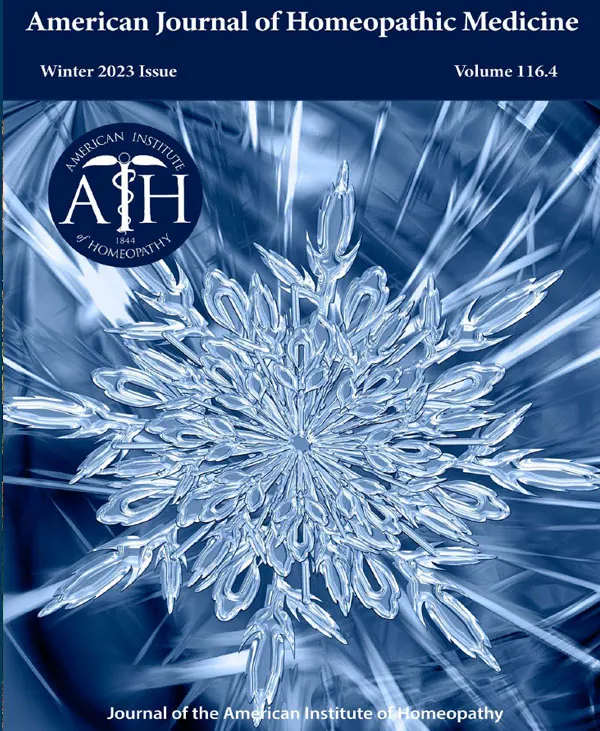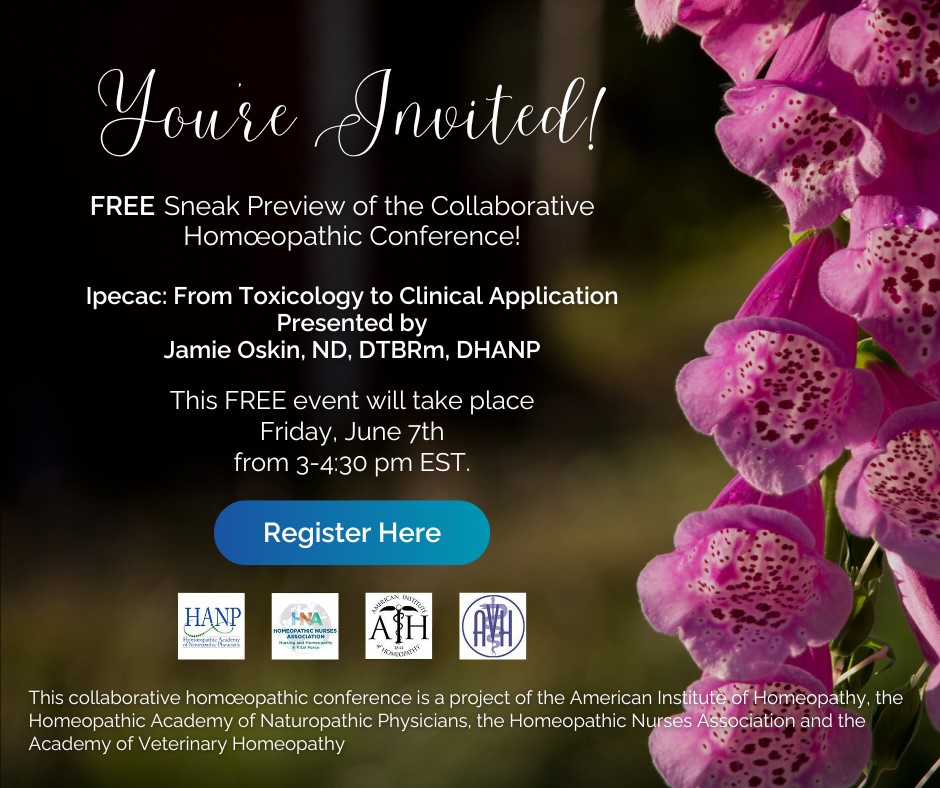
A Comparison of Characteristic Symptoms of Antimonium tartaricum and Phosphoric acid in Severe Respiratory Illness of COVID-19
Alex Bekker, MD, ABIHM
Keywords: severe respiratory illness; Antimonium tartaricum, Phosphoricum acidum
“In this quest for a homoeopathically specific remedy; i.e., in comparing the totality of symptoms of the natural disease with the symptom lists of available medicines so as to find a disease agent similar to the trouble being treated, the more striking, strange, unusual, peculiar (characteristic) signs and symptoms in the case are especially, almost exclusively, the ones to which close attention should be given, because it is these above all which must correspond to very similar symptoms in the symptom list of the medicine being sought if it is to be the one most suitable for cure … “ (Organon, S. Hahnemann, Aphorism 153, p. 125, J. Kunzli edition.)
Introduction
There may be a necessity at the time of convalescence from an acute illness such as COVID-19, especially if it has been unusually severe, to utilize a remedy that was specifically indicated at the time of the acute illness. (This is not uncommonly found to be the case in the utility of Gelsemium sempervirens directly after influenza.) However, this certainly would not obviate the use “miasmatic” treatment later on if the symptoms persist (as in Post Covid-19 Syndrome or Long-haul Covid). The two remedies described here have been commonly needed during the acute outbreaks of severe COVID-19 disease, but the opportunity to treat these patients at that time may not present itself for many practicing in the Western countries. Both Antimonium tartaricum and Phosphoric acid demonstrate a dramatic and characteristic drug picture as related to respiratory illness that explains their relatively common use in COVID-19. It is for the purpose of comparison and contrast of the characteristic modalities and concomitants of each that they are presented here in the brief but characteristic outline form of the materia medica.
I would encourage readers to work on their own “repertory” of characteristic symptoms of the remedies found commonly in the treatment of COVID-19 based on the classic authors of our literature: S. Hahnemann, C. Hering, E. Lee, T.F. Allen, Lilienthal, W. Boericke, H.C. Allen, A. Lippe, C.M. Boger, etc. We would welcome this short repertory as a submission for publishing in our journal.
Antimonium tartaricum
REGION:
MUCOUS MEMBRANES.
Pneumogastric nerve: Bronchi. Lungs. Heart. CIRCULATION.
Respiration.
Stomach. Bowels. Sleep.
Lumbar region.
Skin.
[Old people and children]1
WORSE:
WARM: Room. Wraps. Weather.
Anger. Lying.
Morning. Overeating.
Cold. Dampness.
BETTER:
Expectoration.
Sitting erect.
Motion.
Vomiting.1
[Cool air.]2
“Its great characteristic is large accumulations of mucus [with coarse rattling]4 in the bronchial tubes [but] expectorated with [great] difficulty … [Crushing weight on chest.]1 There is a short, hoarse, weak, nearly suffocating breathing, [with dilated, fan-like motion of the wings of the nose—Complete Repertory—(symptom not present in Phosphoric acid)], with whistling noise; throat expands with difficulty, the head is thrown backward with great anxiety and prostration [similar to Arsenicum album, but it is generally worse from cold while head is better from cold], the face is livid and cold [or pale, or blue, cyanotic]4 and the whole body may be covered with a cold perspiration … Cyanosis is common and the patient suffers from a dyspnea which causes him to sit up … bronchial catarrh, when there are nausea, vomiting, loose stools, prostration, cold stupor and drowsiness … The patient craves acids [which disagree]1 or [fruits and apples1], or alcoholic stimulants.
[One of our best remedies for hepatization of the lungs remaining after pneumonia, vying with Sulphur]”4
Characteristic Symptoms of Tartar emetic
- The head trembles, particularly when coughing, with an inward trembling and drowsiness, more in the evening and in warmth.
- Beating and throbbing in all the vessels of the body …
- Coughing and gasping consecutively, particularly in children, with crying or dozing, and twitching of facial muscles1 [child clings to those around; wants to be carried; [but irritable,] cries and whines if anyone touches it.]4
- Intense and long-lasting nausea and vomiting, with great anxiety … [More so than in Phosphoric acid. Vies with Ipecac. whose intense nausea is not better with vomiting]4
- Cannot keep the eyes open, irresistible sleepiness, and dull stupefied sleep; when awake, hopelessness and despair or chill and fever, or vomiting of food. [In pneumonia, Opium is similar but with the face being dark red or purple, with sighing or stertorous respiration.]”4
- “Heat aggravates; cool air relieves”2 [The opposite of Phosphoric acid]
 Comparison of Keynote Highlights
Comparison of Keynote Highlights
Phosphoricum acidum
REGION:
MIND. Nerves.
Metabolism.
Sexual system.
Spine: Sensory nerves. Muscles.
Bones.
WORSE:
DEBILITY from: LOSS OF FLUIDS. Sexual excesses. Fatigue.
Fevers. Convalescence.
EMOTIONS (chronic): Grief. Chagrin. Mental shock. Unhappy
love. Homesickness.
Drafts. Cold.
Music. Talking.
BETTER:
Warmth. [The opposite of Antim. tart.]
Short sleep.
Stooling.1
“Periosteal pains, “as if the bones were scraped” … In the chest complaints … the cough is excited by tickling low down in the chest in the neighborhood of the epigastrium, it is worse in the evening and from lying down. The cough causes headache (Bell., Nat. mur., Phos., Sulph.), nausea and vomiting of food and spurting of urine (Caust. Nat. mur., Puls., Sep.) The sputum is copious, mucopurulent, salty, bloody, and offensive. [Dull, sunken eyes with blue circles; they feel pressed out]1 [Stannum has sputum thick, heavy, and sweetish.]4 Every draught of air causes a fresh cold. The chest feels weak from talking (Stann.) and coughing, but relief is obtained from walking … “ [Thirstlessness during chill and fever, and desires juicy things (both symptoms in Anttart. See Complete Repertory.)]
LEADING INDICATIONS.
- Mental and nervous debility; mild, yielding temperament [As opposed to the irritability of Antim. tart.]
- In their states of apathy and drowsiness patients can easily be roused to full consciousness, but soon relapse.
- Diarrhea, which is profuse, painless and does not debilitate, and may bring relief.
- Weakness in the chest from coughing and talking [Stann.]
- Sensations of pressure or weight [“crushing” on the vertex, etc.]4
- Passive hemorrhages from mucous surfaces …
- The headaches are worse from noise, especially music, and from movement… 3
COVID-19: Ageusia and Anosmia
Smell wanting, lost; taste, with loss of: Amyg-p., Ant-t., Chlf., Hyos., Just., Kali-bi., Lem-m., Mag-m., Nat-m., PULS., Rhod., Stict., Teucr. – from the Complete Repertory, accessed 06/06/21
Interestingly, one of the sources for Kali bichromicum in influenza is listed as: Green, JM. “Kali bichromicum in Influenza in Washington.“ The Homeopathic Recorder, page 540, 1926.
The reference for smell, wanting/lost after influenza in Magmur. is from JH Clarke’s Dictionary. Magnesium muriaticum has been used in India in COVID-19 cases successfully.]
- Boger, CM. A Synoptic Key to the Materia Medica. B. Jain. New Delhi. 2006. p. 122, 271, 272.
- Rabe, RF. Daily Reference on Homoeopathic Therapeutics. B. Jain. New Delhi. p. 36 – 39.
- Neatby, EA, Stonham, TG. A Manual of Homoeo-Therapeutics. Foxlee-Vaughan. 1987. p. 63, 64, 160.
- Nash, EB. Leaders in Homoeopathic Therapeutics. Boericke & Tafel. 1959. p. 235 – 237, 241, 244
About the AJHM
The American Journal of Homeopathic Medicine (AJHM) is a peer-reviewed scientific journal, specifically intended to meet the needs of physicians involved in the specialty of homeopathy. The editor invites original manuscripts, feature articles, research reports, 'Homeopathic Grand Rounds' cases studies, abbreviated case reports for 'Clinical Snapshots,' seminar reports, and position papers that focus on homeopathy, as well as book reviews and letters to the editor. Click below to subscribe to the Journal.
Latest Issue of the AJHM

AJHM – Winter 2023
Volume 116 Number 4
Table of Contents
- Editorial: In this Issue
- Homeopathic PuZZle?
- A Case of Erectile Dysfunction and Anejaculation in a Diabetic Patient
- Iron and Its Salts: Materia Medica and Illustration
- Suppression in the Organon
- An Appreciation of Jacques Jouanny’s Life and a Review of His Opus “The Essentials of Homeopathic Therapeutics”


